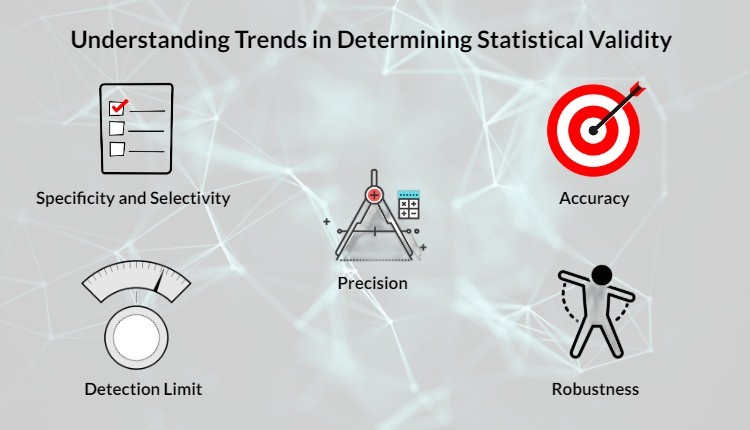What Is Statistical Validity? -Understanding Trends in Validating Research Data

With an aim to understand, analyze, and draw conclusions based on the enormous data often presented in complex formats, it is imperative to validate it statistically. In research, decision modeling and inferential aspects depend on the statistical validity of research data. Thus, it becomes imperative for researchers and statisticians to develop novel frameworks in the statistical paradigm to evaluate and validate research data. In this article, we will explore the recent trends in the statistical validity of research data.
What Is Statistical Validity?
Statistical validity can be defined as the extent to which drawn conclusions of a research study can be considered accurate and reliable from a statistical test. To achieve statistical validity, it is essential for researchers to have sufficient data and also choose the right statistical approach to analyze that data.
Furthermore, statistical validity also refers to whether statistics derived from a research study are in agreement with its scientific laws. Thus, if a given data set draws a conclusion after experimentation, it is said to be scientifically valid and relies on the mathematical and statistical laws of the principal study.
Why Is It Important to Determine Statistical Validity of Research Data?
It is important to determine statistical validity of research data because;
- It allows the analyst to know whether the results of the conducted experiments can be accepted with confidence or not.
- It increases the probability of research reproducibility.
- The researcher understands whether a method of analysis is suitable for its intended use to derive conclusive results.
- It allows the researcher to ensure the validity of research based on its criteria of method selection.
- Furthermore, it also allows the researcher to optimize the number of assays and satisfy the validation criteria of a study.
What Are the Different Types of Statistical Validities?
Statistical validities relevant to research are broadly classified into 6 categories:
1. Construct Validity:
- It ensures that the actual experimentation and data collection conforms to the theory that is being studied.
- It is reflected by a questionnaire regarding public opinion. It provides a clearer image of what people think of a certain issue.
- Construct validity is further divided into 2 types:
A. Convergent Validity– It ensures that if the required theory predicts that one measure is correlated with the other, then the statistics confirm this.
B. Divergent or Discriminant Validity– It ensures that if the required theory predicts that one variable doesn’t correlate with others, then statistics need to confirm this.
2. Content Validity:
This validity ensures that the test or questionnaire that is prepared completely covers all aspects of the variable being studied.
3. Face Validity:
This type of validity estimates whether the given experiment actually mimics the claims that are being verified.
4. Conclusion Validity:
This validity ensures that the conclusion is achieved from the data sets obtained from the experiment are actually correct and justified without any violations.
5. Internal Validity:
It is a measure of the relationship between cause and effect being studied in the experiment.
6. External Validity:
This validity is a measure of how to apply the results from a particular experiment to more general populations. Furthermore, it informs the analyst whether or not to generalize the results of a particular experiment to all other populations or to some populations with particular characteristics.
Understanding Trends in Determining Statistical Validity
1. Specificity and Selectivity
Statistical validity is relevant to specificity—a quantitative indication of the extent to which a method can distinguish between the subject of interest and interfering substances on the basis of signals produced under actual experimental conditions. In case of random interferences, they should be determined using representative blank samples.
2. Accuracy
Accuracy is the closeness of agreement between the true value of the subject being analyzed and the mean result obtained by applying experimental procedure to a larger population or sample size.
3. Precision
While comparing results, they should be analyzed based on their precision of repeatability and reproducibility. In statistics, repeatability can be termed as intra-assay precision.
4. Detection Limit
Detection limit can be determined with several approaches: visual inspection, signal-to-noise, and using the standard deviation of the response and the slope. While presenting, researchers must also ensure that the detection limit and the method used for determining the detection limit is also displayed.
5. Robustness
Robustness of data is the measure of how effectively the performance of the research method stands up to not exactly similar implementation of the approach. Exact same results can only be replicated following a set procedure; however, to avoid the performance to be severely affected, the procedure must be carried out with sufficient care following the procedure efficiently. Such impacting aspects should be identified and their influence on method’s performance must be evaluated using tests for robustness.
What Are the Challenges in Determining Statistical Validity of Research Data?
- Methods are generally developed by the R&D department, whilst the quality assurance and quality control departments conduct data validation. The transfer of methods and data from one department to another is important and must be done scrupulously to ensure proper validation.
- If methods are not built on research robustness, the results delivered may also be affected, eventually leading to lack of efficiency in quality testing encountering lengthy and complicated validation process.
- Inadequate knowledge of design and execution of the studies will hamper the statistical validity of research data.
Statistical validity helps ensure that the developed methods qualify and are capable of their intended use. Which methods do you follow to ensure statistical validity of your research data? Let us know about it in the comments section below.











Good article to read and gain information.
nice article
This article is really helpful thanks once again. I love this site